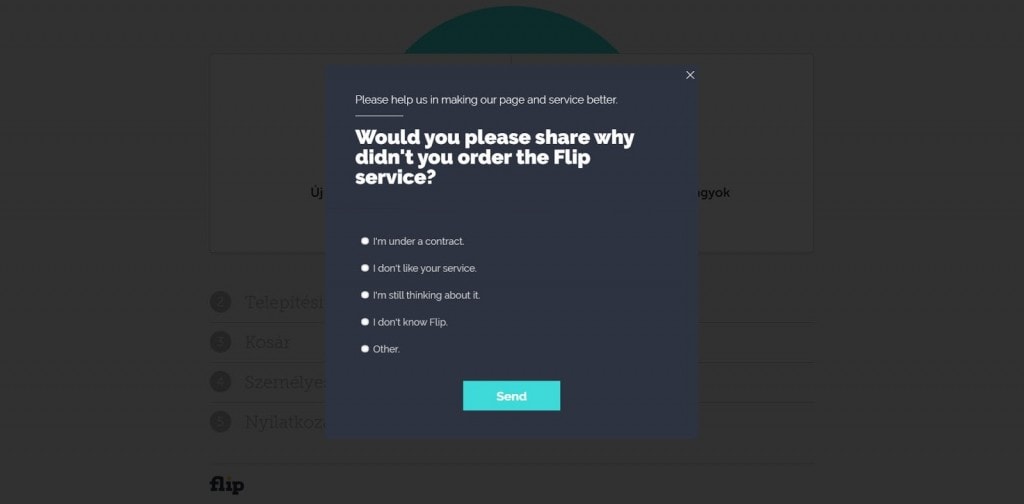Dec 4, 2020 | 11 minutes
7 Ways to Optimize Your Ecommerce Store with Typeform
Learn how to use Typeform to improve your ecommerce business and gain a competitive edge in a simple, structured fashion with the following tips.

Like email, online forms predate internet history landmarks like search engines, payment gateways, and registration systems, helping users and businesses funnel and organize data in an easy manner.
Also like email, online forms are both instrumental and underestimated when it comes to bringing ecommerce stores forward, assisting them in their:
Lead generation efforts
Client support practices
Customer onboarding schemes
Using forms in ecommerce can help you fulfill and improve many important tasks, and this is the topic that occupies us today.
In this article, we will focus on the possibilities Typeform brings to ecommerce businesses, and provide you with a series of tips to gain a competitive edge in a simple, structured fashion.
Before we get into detail, let’s do a quick pan over Typeform, its features, and basic traits.
Let’s go!
Why Typeform? Features, pricing, integrations
There are many excellent form-building tools out there, but we decided to build our case around Typeform for three simple reasons:
It is a leading product in the online forms space
It provides a novel approach to form building
It can be easily integrated with other apps using Make
Among its most salient features, we can count:
The user-friendly interface
Conditional logic capabilities for question branching (called “Logic Jumps”)
Lots of form customization options
Capacity to integrate payment processing platforms into forms (Stripe)
Advanced embedding options
As for pricing, Typeform offers three different plans, ranging from $35/mo to $70/mo. In this area, the company doesn’t stand out from its main competitors, most of which offer solutions within a similar price range.
On top of this, Typeform is very easy to integrate with other apps, and although it doesn’t feature many native integrations, it’s easy to connect it to hundreds of different apps using platforms like Make. But more on this later.
Now, let’s take a closer look into what matters the most: using Typeform to optimize your ecommerce store.
7 ways to use Typeform for ecommerce optimization
As we mentioned above, it’s easy to underestimate the power of online forms. In the list below, we will show you seven actions you can implement right away to optimize your ecommerce business.
1. Get creative with email marketing campaigns
Online forms allow you to avoid the commonplaces of email marketing by providing an interactive experience to your customers and prospects. On top of interactive, the use of forms in email marketing also tends to be transactional in nature.
In other words, when you send forms, interactions do not happen just because; instead, they are driven by a clear purpose and facilitated by a smooth user experience.
Credit: Typeform
With this in mind, you will need to evaluate what you will be offering your audiences in exchange for their answers.
For instance, let’s imagine that you run a menswear brand, and that you need to accomplish two goals:
Sell your old inventory as fast as possible
Get new style ideas for the next summer season
To accomplish this, an email marketing campaign with an embedded Typeform could be the answer you are looking for.
How? There are many ways, but offering a heavy discount on clothing items in exchange for feedback over fashion styles would be an interesting path to explore.
In this example, we can see all the elements laid out above playing together:
An interactive exchange (“Tell us your thoughts about these shirt styles”)
The transactional nature of the exchange (“and get a 50% discount on skinny chinos”)
A smooth user experience (guaranteed by the use of a nimble Typeform form)
To conclude, it’s important to note that interactive exchanges are instrumental in building trust and confidence with your customers.
People value being heard, and online forms are a great way to bring the human upfront.
2. Make it easy for customers to provide feedback
We all know how important feedback is for ecommerce, and how it improves everything from online user experience to offerings and marketing efforts.
The question, however, is how to create an efficient feedback loop that doesn’t drain your company’s time and resources.
The first thing to know about feedback loops is that they can be active or passive.
Passive feedback requires the user to initiate the feedback loop, and this can be attained by:
Having a contact page available
Placing buttons or links for providing feedback in the pages visited by the customer
Active feedback, on the other hand, is brought to the attention of the user and often triggered by actions. Example of active feedback include:
Popups that appear on screen after a certain action is completed (i.e. after making a purchase)
Feedback requests sent over email
Microinteractions on digital products and web feeds
Credit: OptiMonk
Typeform forms can be used to create both passive and active feedback loops. For example, by placing buttons leading to a Typeform feedback form across your site, you’d be covering the passive feedback loop base.
However, we consider that ecommerce businesses will benefit the most from active feedback loops, as they provide an opportunity to gather fresh opinions from customers.
There are many ways to use Typeform in an active feedback loop. Email is, perhaps, the easiest one.
For example, a few months ago, we wrote a short guide to automatically sending “Thank you” emails to new Shopify customers.
As you can sense, this Make automation does a very simple thing: every time a customer registers to your store, it automatically sends a “Thank you” email to the customer.
Since our goal here is to ask for feedback, it would be easy to modify the contents of the email to include a Typeform form and ask for feedback. This way, you can guarantee that every customer that registers at your store will get a feedback form.
From then on, all you have to do is sit and wait for the answers to start pouring in.
3. Build buyer personas in record time
Buyer personas (also known as “user personas”, or simply “personas”) are representations of your users based on data.
In other words, buyer personas are constructions, fictional characters that display a series of real and ideal traits your customers possess.
In a number of cases, some of these traits can be easily pinned down, while others need to be researched to become visible.
For example, it wouldn’t be far-fetched to characterize a buyer persona of a company selling running shoes as someone who enjoys being outdoors.
But why is this important? Simple: you have to know your customers to satisfy them in the best possible way.
Needless to say, this knowledge can not and should be not left to guesswork, and here is where Typeform can help.
To boost your buyer persona building efforts, you can use Typeform’s buyer persona survey templates, and either deploy the surveys on your site or send them via email.
Once again, it’s important to observe the transactional nature of these interactions, and offer something in exchange for answers.
Also, keep in mind that extremely personal questions can easily scare your users away, so play special attention to the questions you will ask in the survey.
Credit: Typeform
Another interesting factor to take into account is timing. For example, it is not rare for customers to leave reviews on a company’s Google My Business profile.
These customers can become a great source of information for building a buyer persona, and keeping a close eye on these reviews is something you may want to consider.
What’s most, you can ask them to complete a survey by commenting on their reviews as these get posted on your Google My Business page.
Use this template to automatically reply to Google My Business reviews
4. Bridge the gap between digital and physical sales
Out of all the things that became evident during the COVID-19 pandemic, it was the gap between digital and physical sales that caught the most of our attention.
For reasons we all know about, millions of physical stores were forced to start selling online, only to find themselves trapped in a labyrinth of tools, methods, platforms, and solutions.
The problem with this situation is clear: a large number of these companies required the simplest possible solution to sell online. Unfortunately, many went down after not finding what they needed, at the time they needed it the most.
Credit: Unsplash
Needless to say, there are countless solutions to sell online; however, we found out that using Typeform can significantly facilitate the process.
How? By using Typeform’s order forms, and keeping them upfront for your customers to place their orders.
This of course depends on what you sell and how many items your store features, but for the majority of ecommerce businesses out there it represents a simple, user-friendly method.
The secret to it is quite simple:
Rely on clear, concise landing pages
Deploy a button up front to trigger the order form
Integrate a payment method into the form (more on this below)
And that’s it.
You can further improve the process by funnelling every Typeform entry into Google Sheets (or into your email inbox) to accelerate the order fulfilment process even more.
Use this template to automatically save new Typeform entries to a Google Sheets spreadsheet
If you wish to learn how businesses around the world used Typeform to bridge the gap between digital and physical sales, we recommend reading this post from the Typeform blog for inspiration.
5. Let users customize their orders
Long gone are the days of Henry Ford, when any customer could have a car painted any color he wanted...as long as it was black.
We now live in the era of personalization, powered by:
Data
Individual consumer choices
Technology
Shopping for something goes beyond fulfilling a real or perceived need: it is a mean of self-expression, a statement in itself. We buy something to say “this is who we are, what we think, and what we believe in”.
This is why order customization is so important: it gives your customers the possibility to get exactly what they want.
Credit: Unsplash
Using Typeform orders, you can let users customize their orders as much as possible. What’s most, customization goes beyond picking sizes, colors, and configurations; you can offer custom options for:
Quantity
Packaging
Shipping and delivery
Warranties
To do so, you will have to:
Place a button that triggers the opening of an order form (i.e. “Shop this”)
Create a Typeform order form that starts with basic customization steps (i.e. size, color)
Add as many customization steps as your product and business allows (i.e. shipping, packaging, and so on)
Remember to keep an eye out for inventory levels and product availability, as you will not wish to get your customers’ hopes up and then fail to satisfy them.
6. Funnel data to where it belongs
Keeping up with form responses in a structured, organized manner is a major issue for many ecommerce businesses.
This tends to happen for two reasons:
Form answers arrive in a haphazard, asynchronous way
Companies use several forms for different purposes, losing track of what answer belongs to which campaign
There’s no point in feeling bad when this happens, as there are two alternatives to keep your form answers organized:
First, and very obviously, is to get serious with organizing your data. This will require you to keep track of answers and set a routine to manually organize them
The second alternative is easier and certainly less time-consuming. It will require you to integrate Typeform with a spreadsheet like Google Sheets (or Excel 365, or Airtable).
By doing this, you will be able to automatically funnel Typeform answers into a specific spreadsheet for each campaign (in the case you have several different forms out there).
Needless to say, spreadsheets are the most common repository for answers you can set your hands-on, but it is also entirely possible to integrate Typeform with task management tools (ClickUp, Trello), and also with CRMs (HubSpot, Pipedrive).
Use this template to automatically send new Typeform entries to Airtable
In addition to storing answers, there is the problem of notifications, since form answers can act as triggers for a series of tasks.
Think orders, for example. Whenever an order is placed, a series of tasks that need to be completed is triggered, including:
Inventory update
Registration of the order in your accounting system
Locating the product in your storage
Labelling and packaging
Scheduling the shipping
Shipping
Some solopreneurs are in charge of the whole fulfilment process, but as an ecommerce business becomes more successful, more people are involved in completing these tasks.
This is where notifications kick in.
Creating automatic notifications for Typeform entries is easy with tools like Make. You can:
Pick who gets notified whenever a new Typeform answer is submitted
Choose the medium: email, Slack, ClickUp, Trello, and more
Create the integrations yourself, or else use one of the available templates
Use this template to automatically send Slack messages for new Typeform entries
By consolidating form responses into a repository (spreadsheet) and setting up automatic notifications, you will be able to keep track of your data and act upon it on time, never missing a beat.
7. Integrate payments into your Typeform forms
Our final optimization tip for using Typeform in ecommerce is the one that closes the purchasing circle: payment gateway integrations into your Typeform order forms.
This feature is what makes Typeform such an attractive ecommerce solution for businesses that wish to keep things simple - both for themselves and for customers.
As it turns out, Typeform is a verified Stripe partner, which allows them to offer a seamless solution to embed a payment method into your forms: the Stripe payment block.
The Stripe payment block is quite self-explanatory: it’s a piece that you insert in your order form (usually, at the end), and that customers will use to complete their purchase.
Since this is a Typeform - Stripe integration, you will be bound to Stripe’s conditions when using the payment block to process your customer purchases, namely:
No monthly fee, pay-as-you-go model
Online processing fee: 2.9% + $0.30
As long as your business has a Stripe account, you will be able to use this integration from the get-go and rely on forms to get and process your customer’s orders in full.
Conclusion: Everybody loves an interesting conversation
Our final observation regarding the use of Typeform for ecommerce is how this tool turns mechanical information exchanges into conversations.
Let’s face it: for decades, forms stood out as a tedious, repetitive method to gather data. Customers didn’t like to fill forms, and businesses didn’t like to process them.
Fortunately, all of these changes with Typeform. By offering a nimble, fluid experience, the company has been able to eliminate the tediousness associated with filling a form, while keeping data structured for those who create and use them.
This way, forms re-emerge as a new method to communicate with users in an engaging manner.
Call it a user experience triumph if you want, but most importantly: don’t miss out on it.












